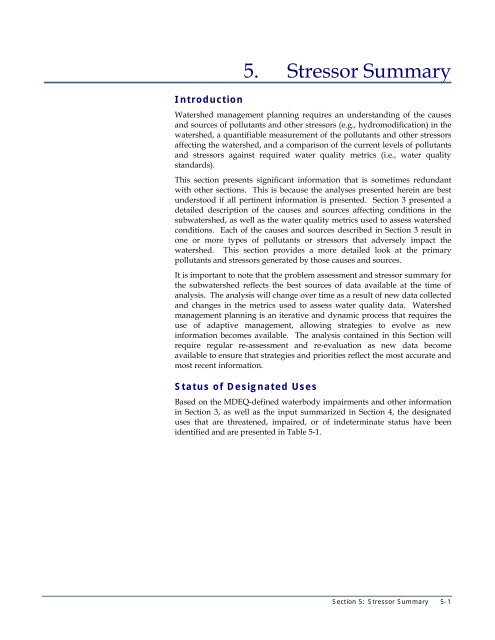Looking Glass River Watershed Management Plan - Greater ...
Looking Glass River Watershed Management Plan - Greater ...
Looking Glass River Watershed Management Plan - Greater ...
You also want an ePaper? Increase the reach of your titles
YUMPU automatically turns print PDFs into web optimized ePapers that Google loves.
Introduction<br />
5. Stressor Summary<br />
<strong>Watershed</strong> management planning requires an understanding of the causes<br />
and sources of pollutants and other stressors (e.g., hydromodification) in the<br />
watershed, a quantifiable measurement of the pollutants and other stressors<br />
affecting the watershed, and a comparison of the current levels of pollutants<br />
and stressors against required water quality metrics (i.e., water quality<br />
standards).<br />
This section presents significant information that is sometimes redundant<br />
with other sections. This is because the analyses presented herein are best<br />
understood if all pertinent information is presented. Section 3 presented a<br />
detailed description of the causes and sources affecting conditions in the<br />
subwatershed, as well as the water quality metrics used to assess watershed<br />
conditions. Each of the causes and sources described in Section 3 result in<br />
one or more types of pollutants or stressors that adversely impact the<br />
watershed. This section provides a more detailed look at the primary<br />
pollutants and stressors generated by those causes and sources.<br />
It is important to note that the problem assessment and stressor summary for<br />
the subwatershed reflects the best sources of data available at the time of<br />
analysis. The analysis will change over time as a result of new data collected<br />
and changes in the metrics used to assess water quality data. <strong>Watershed</strong><br />
management planning is an iterative and dynamic process that requires the<br />
use of adaptive management, allowing strategies to evolve as new<br />
information becomes available. The analysis contained in this Section will<br />
require regular re-assessment and re-evaluation as new data become<br />
available to ensure that strategies and priorities reflect the most accurate and<br />
most recent information.<br />
Status of Designated Uses<br />
Based on the MDEQ-defined waterbody impairments and other information<br />
in Section 3, as well as the input summarized in Section 4, the designated<br />
uses that are threatened, impaired, or of indeterminate status have been<br />
identified and are presented in Table 5-1.<br />
Section 5: Stressor Summary 5-1





